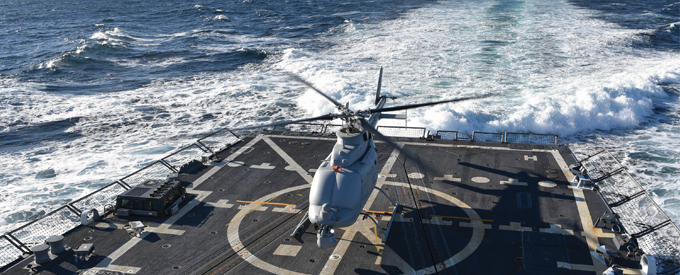2017-05-13
Spotlight on NGC’s MQ-8C
Northrop Grumman Corporation’s autonomous helicopter, MQ-8C Fire Scout, recently took to the air for the first time from a U.S. Navy independence-class Littoral Combat ship, USS Montgomery (LCS-8). The flight took place off the coast of California during the second phase of Dynamic Interface testing, demonstrating Fire Scout’s stability and safety while operating around the ship.
The two week at-sea event allowed the U.S. Navy to test the MQ-8C Fire Scout’s airworthiness and ability to land and take off from a littoral combat ship throughout a broad operational envelope. The MQ-8C Fire Scout conducted its initial at-sea flight test aboard the guided missile destroyer, USS Jason Dunham (DDG-108) in December 2015.
“Fire Scout’s successful testing aboard USS Montgomery and USS Dunham proves its capability to fly from multiple air capable ships,” said Capt. Jeff Dodge, program manager, Fire Scout, Naval Air Systems Command. “We plan to have the MQ-8C Fire Scout deployed aboard multiple ships in the near future giving the fleet the persistent intelligence, surveillance, reconnaissance and targeting asset they need.”
With the completion of Dynamic Interface testing, the MQ-8C Fire Scout is one step closer to Initial Operational Test and Evaluation (IOT&E) and full operational deployment.
“Fire Scout’s autonomous technology coupled with the range and endurance of the MQ-8C airframe is truly a game-changer,” said Leslie Smith, vice president, tactical autonomous systems, Northrop Grumman Aerospace Systems. “When the MQ-8C deploys with its advanced AESA maritime radar, the U.S. Navy will have unmatched situational awareness and the ability to provide sea control in any contested maritime environment.”
The MQ-8C Fire Scout builds on the ongoing accomplishments of the MQ-8B Fire Scout program. Helicopter Squadron 23 is currently operating onboard the deployed littoral combat ship, USS Coronado (LCS 4), with two MQ-8B Fire Scouts in the South China Sea.
Fire Scout is a combat proven, unmanned helicopter system that provides real-time Intelligence, Surveillance and Reconnaissance (ISR), target-acquisition, laser designation, and battle management to tactical users without relying on manned aircraft or space-based assets. Fire Scout has the ability operate from any air-capable ship or land base in support persistent ISR requirements.
Fire Scout variants
There are two Fire Scout variants, the smaller MQ-8B and the MQ-8C. MQ-8B has deployed on multiple frigates and is currently deployed on a Littoral Combat Ship (LCS). MQ-8B is also deployed to Afghanistan to support counter- improvised explosive device (IED) operations. This system has completed more than 15,650 flight hours.
The Navy has integrated a multi-mode maritime radar on MQ-8B and tested an onboard weapons capability, the Advanced Precision Kill Weapon System (APKWS). The MQ-8B Fire Scout has also demonstrated the ability to operate concurrently with other manned aircraft while operating at-sea.
The MQ-8C is the Navy’s next generation unmanned helicopter. The MQ-8C Fire Scout’s airframe is based on the commercial Bell 407, a mature helicopter with more than 1,400 airframes produced and over 4 million flight hours. Combined with the maturity of Northrop Grumman’s unmanned systems architecture, Fire Scout meets customer requirements for ship-based and land-based unmanned systems.
It also has the ability to autonomously takeoff and land on any aviation-capable ship and from prepared and unprepared landing zones. This enhancement significantly increases range and endurance (more than double) and payload capacity (more than triple). The MQ-8C has completed developmental testing and is ready to deploy.
MQ-8C Fire Scout combines the best of two proven air systems in a low-cost, fast-fielding package. The expanded capability unmanned air system offers the versatile reconnaissance, surveillance and target acquisition architecture of the U.S. Navy’s MQ-8B Fire Scout, and the extended range, payload and cargo hauling capabilities of the commercially mature Bell 407 helicopter.
The MQ-8C Fire Scout is a fully autonomous, four-blade, single-engine unmanned helicopter. Like the MQ-8B, it can carry an array of ISR sensors to support the warfighters’ demand for enhanced situational awareness. The MQ-8C extended cargo and payload capability and the increased endurance deliver additional mission flexibility to commanders on the ground.
Fire Scout supports both maritime- and land-based missions. The MQ-8C has been designed to communicate easily with shipboard controllers using the Navy’s Mission Control System.
The MQ-8C Fire Scout delivers what military planners want, and what warfighters need. This reliable, low-cost vertical unmanned system is versatile enough to support intelligence, surveillance and reconnaissance, cargo, and communications requirements of land and sea forces, while being rugged and persistent enough to stay in the fight until the mission is complete.


No Comments